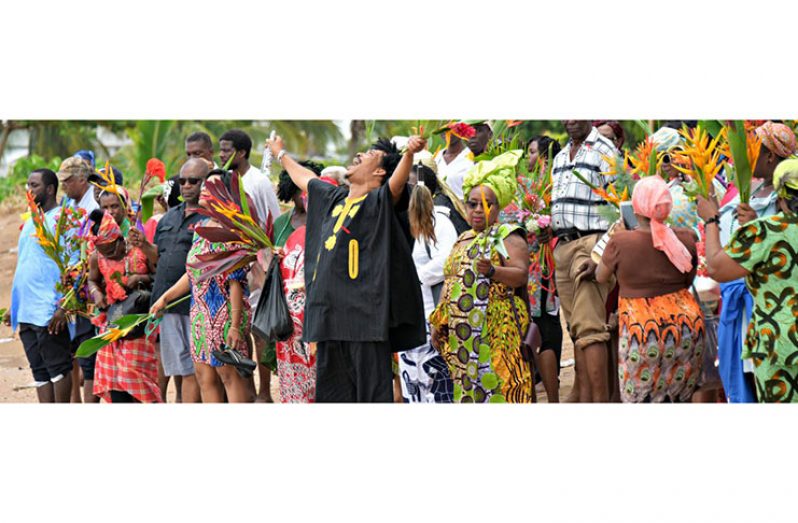Before December 26, the first day of Kwanzaa, the day of Umoja or Unity, the entire house is cleaned. The home is then dressed in the colours of red, green and black. African motifs are often displayed along with other cultural articles.
The Kwanzaa table or corner is set up in the home. The table consists of the Kwanzaa symbols. First the straw mat is laid. On this mat rests the other symbols and articles. The candleholder with the seven candles is then placed on the mat, along with the bowl of fruits and ears of corn. Any other product which the family has produced during the year can also be displayed.
On the morn of the 26th, the entire family gathers around the Kwanzaa table. Libations are offered to the creator and ancestors. The candle is then lit, starting with the red candle. The family then discusses their failures and achievements in fostering unity in the family and community over the past year. Habari Gani (or what is the news for today?) is asked. Unity or Umoja is the answer given by others. The candle of Umoja is then lit. It is important that the children and elders participate in the ceremony with the view of bridging the generational gap, thus continuing the tradition. If anyone has exemplified this principle during the previous year, Zwadis or gifts are given.
This ceremony is repeated with each principle being the center of discussing for the next seven days.
A community feast or family gathering occurs on any day during the seven days of Kwanzaa. On this day the entire family/ community assesses its failures and accomplishments, and establishes goals for the upcoming year, in achieving the principles of Kwanzaa. Elders, youths, and other persons who have upheld any of the principles are honoured accordingly. Since Kwanzaa is a family oriented celebration, the entire family is expected to participate.
KWANZAA: AN AFRICAN HARVEST FESTIVAL
In many traditional agricultural societies the harvest is an important celebration for the family and community.
Agricultural societies in Africa celebrated the harvest in various ways. Harvest time meant not only a “ Celebration after hard work”, but also an assessment and evaluation of the past year’s achievements and failures.
The origin of Kwanzaa (a Swahili word meaning “first fruits”) is to be found in the agricultural and harvest celebrations of traditional African societies. Kwanzaa contains the key elements of these celebrations. These elements are:
? The ingathering of people
? Reverence for the Creator and Creation
? Commemoration of the past
? Recommitment to the basic tenets of African culture
? A celebration of the good
The seven day celebration which runs from December 26 to January 1 is a synthesis of various continental and Diaspora African cultural elements. It also incorporates those values that are essential to Africans throughout the world in their various struggles.
PRINCIPLES
At the core of Kwanzaa is the Nguzo Saba or seven principles. These are the minimum set of values needed by Africans to reconstruct their lives in their own image, to build their communities and to resuscitate their culture. The Nguzo Saba are:
1. Umoja (Unity)
* To strive for and maintain unity in the family, community and race.
2. Kujichagulia (Self Determination)
* To define ourselves instead of being named, spoken for and created by others.
3. Ujima (Collective work & responsibility)
* To build and maintain our own manufacturing and commercial businesses and financial organizations, and to profit from them.
4. Ujamaa (Co-operative Economics)
Collective economic strength.
5. Nia (Purpose)
* To make our collective vocation the continuing development of our community in order to restore our people to their traditional greatness.
6. Kuumba (Creativity)
* To do always as much as we can, in any way that we can, in order to leave our community more beautiful and beneficial than we inherited it.
7. Imani (Faith)
* To believe with all our heart in our people, our parents, our teachers, our leaders and the righteousness and victory of our struggle.
SYMBOLS
The symbols of Kwanzaa are a straw mat, a candle holder, a bowl of fruits, seven candles and ears of corn.
* The straw mat symbolizes our rich traditions and is the foundation of all the other symbols.
* A bowl of fruits signifies rewards after hard work.
* The seven candles symbolize the seven principles.
* The ears of corn symbolize the ability of Africans to reproduce and service despite various setbacks.
The colours of Kwanzaa are red, green and black.
* Red signifies the blood shed through the various struggles of Africans all over the world.
* Green signifies the richness and fertility of the African continent.
* Black signifies the color of the people.
Pic save as kwanzaa



.jpg)








